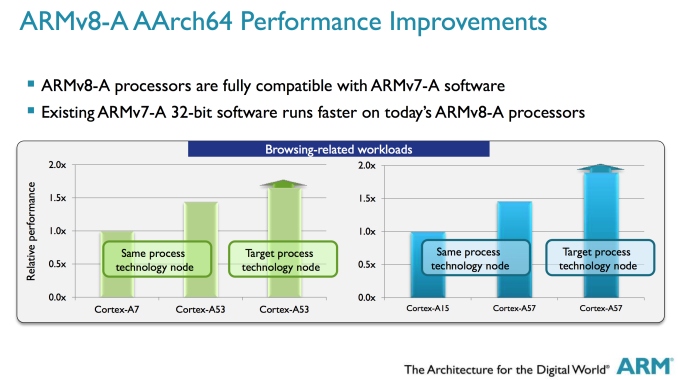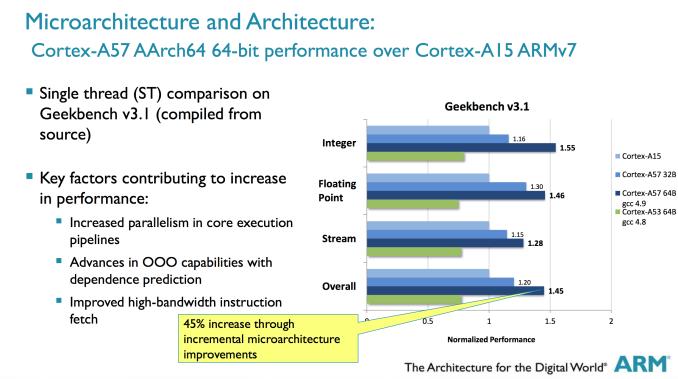ARM Shares Updated Cortex A53/A57 Performance Expectations
by Anand Lal Shimpi on May 6, 2014 8:00 AM EST- Posted in
- SoCs
- CPUs
- Arm
- Cortex A53
- Cortex A57

With the first Cortex A53 based SoCs due to ship in the coming months, and Cortex A57 based designs to follow early next year, ARM gave us a quick update on performance expectations for both cores. Given the timing of both designs we'll see a combination of solutions built on presently available manufacturing processes (e.g. 28nm) as well as next gen offerings (20/16FF). The graph above gives us an updated look at performance expectations (in web browsing workloads) for both ARM 64-bit cores.
If we compare across the same process nodes (28nm in both cases), the Cortex A53 should give us nearly a 50% increase in performance compared to ARM's Cortex A7. The Cortex A57 should offer roughly the same increase in performance compared to Cortex A15 as well. Although the A57 will do so at higher power, power efficiency may be better depending on the workload thanks to the added performance. Thankfully we won't see many A57 designs built on 28nm in mobile (AMD's first Cortex A57 design will be aimed at servers and is built on a 28nm process).
If you combine architectural improvements with a new process node, the gains are substantial. Move to 20nm or 16FF for these designs and the improvement over their 32-bit predecessors easily exceeds 50%.
ARM also provided some Geekbench 3 performance data comparing the Cortex A57 to A15, both in 32-bit and 64-bit mode. We already know Geekbench 3 is particularly sensitive to the new instructions that come along with AArch64, but even in 32-bit mode there's still a 15 - 30% increase in performance over the Cortex A15 at the same clocks.
Qualcomm has already announced its Snapdragon 410, 610 and 615 will use ARM's Cortex A53, while its 808 and 810 will use a combination of Cortex A53s and A57s.











37 Comments
View All Comments
Wilco1 - Wednesday, May 7, 2014 - link
More interestingly, how does it compare to a low clocked Haswell, say the ones used in Chromebooks? Benchmarks showed those were ~2x faster than the original Samsung Chromebook (1.7GHz dual A15). The slides above say A57 will be twice as fast as the latest 28nm A15s, so should be able to match or beat those. And that is very interesting as it shows ARM is getting the level of performance of a typical cheap laptop/PC.darkich - Wednesday, May 7, 2014 - link
..even if it doesn't match a low power Haswell in performance, it will absolutely trump it in perf./watt.But I am more interested in seeing the A8 from Apple.
That one should beat the most frugal Haswell variants even performance wise
errorr - Wednesday, May 7, 2014 - link
Qualcomm will be fine even if they just have vanilla cores and the customer comes later. Premier tablet chips are a tiny niche market and the money is made in smartphones. They might lose some market share outside the US but there won't be a premium US phone that moves away from QC because of their modem and IP integration. Nobody can beat QC in price/performance in the US because of CDMA and 2g legacy IP which it luckily doesn't have to pay itself for.If VoLTE was fully deployed then maybe an LTE only flagship may debut but that is at least a year from being viable on Verizon and even longer on other networks. QC has to be the choice for US markets and unless you are Samsung it isn't worth building 2 phones to market to non US customers. Also QC pays the freight for network tests and certification required by the big US telcos which is just another reason QC dominates on price.
We won't have tried SOC competition until the bog networks start shutting down their 2g bands and migrate fully to LTE. VoLTE will be the real game changer as the licensing costs for the IP is cheaper and easier to implement with a lot of competing modem techs available.
CiccioB - Wednesday, May 7, 2014 - link
1. High level tablets use SoCs that have more profit margins than those used in phones2. Phones SoC are very low cost and very low margins, and Qualcomm position on low market (the one with bigger selling numbers) has already been taken by Chinese and Tawainese SoC producers. If SoC producers like Chinese and Taiwanese ones can offer a SoC + separate modem at a lower price then Qualcomm integrated SoC then Qualcomm advantage is gone.
2. Modem integration is still what gives advantages to Qualcomm in mid/top market. But take into account that USA is not the only market on the planet, as Europe and Asia greatly out numbers it by selling numbers and Qualcomm USA only modems are not required there.
darkich - Wednesday, May 7, 2014 - link
"High level tablets use SoCs that have more profit margins than those used in phones"On what planet??
Ever since the very introduction of low voltage ARM soc's, the highest end ones are going to Smartphones first.
It is by far the most dominant platform and tablets don't come even close
CiccioB - Wednesday, May 7, 2014 - link
On what planet what?In tablets SoCs can be bigger or of less "quality" than those used for phones, as in tablets power contraints are a less critical. If you speak for numbers, yes, tablets have a smaller market, but it is not sure that they have such a smaller profit.
darkich - Wednesday, May 7, 2014 - link
Your quoted statement is wrong unless you are referring to Haswell chips.I repeat - high end phones get the best and most powerful ARM chips.